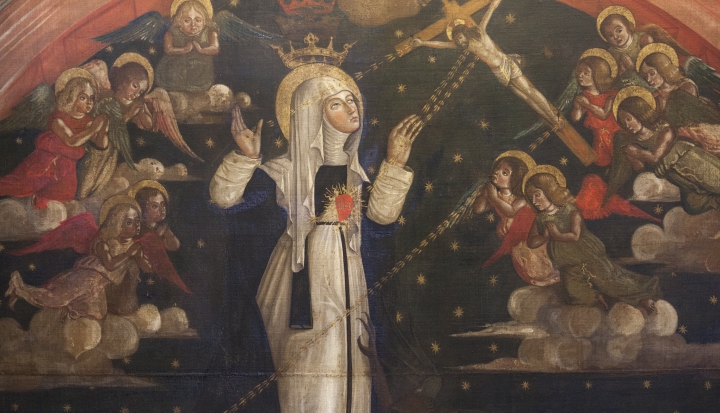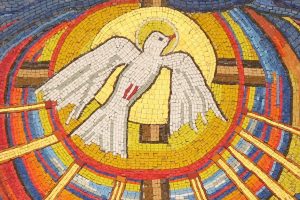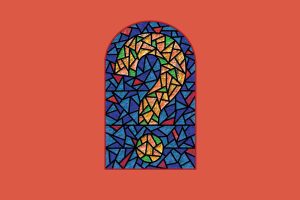There’s a common stereotype about women in the medieval church. We often talk about female saints like Hildegard of Bingen, Julian of Norwich, or Catherine of Siena like they were perfect examples of feminine wisdom, virgin saints who cared for others and spread holiness through their ministry to the poor.
Elizabeth Dreyer, professor emerita of religious studies at Fairfield University, has been studying these women for decades. She warns that these stereotypes sometimes keep us from figuring out who these women actually were and what they believed. “For women like Catherine of Siena, we have to sort out the stories that were passed down from the actual Catherine of history,” Dreyer says. “They don’t always reflect the Catherine we all know and love; she isn’t quite the Catherine who actually existed.”
Luckily, the true stories of medieval women can often be as fascinating, if not more so, as their conventional hagiographies. Dreyer says that although she’s been reading and researching medieval women for so long, her interest in them has not dimmed. “They’re interesting. They’re quirky. They’re crazy. They’re profound,” she says. “They’re my teachers, my spiritual directors, and companions.”
These women aren’t just interesting stories; they’re role models for people of faith today. According to Dreyer, Catherine of Siena and women like her can teach us about our own lives as people of faith. The language Catherine used for God, how she interacted with the world, and how she fought to reform the Catholic Church are lessons for Catholics today.
Who was Catherine of Siena?
We know that Catherine lived in the 14th century. She died in 1380 at the age of 33 and was from a family of wealth—members of the merchant class. Her father was a dyer. Her family was very wealthy, and she had a lot of doors that were open to her in both the political and religious realms. Her brothers were very active in Italian politics, which were rough, violent, and vindictive. She was raised in that milieu and took to it herself. Like Hildegard and a lot of aristocratic women who became recognized as saints, she hobnobbed with a lot of very important people.
Catherine was the 24th of 25 children; she had a twin who died. She was very close to one of her sisters, Bonaventura, who married, had children, and died young. It’s impossible for us to know what impact Bonaventura’s death had on Catherine, but she clearly did not want to follow Bonaventura’s route and get married. That’s the path her parents would have expected, for all kinds of reasons—extending the family, wealth, connections, etc. So her family pushed really hard to get her to do things their way.
I always say that Catherine was made Cinderella in this large household. It wasn’t even just her brothers and sisters; the family took in people like Tommaso, Catherine’s cousin whose parents died. (He later became a Dominican and was her first confessor.) I get the feeling there was always room for one more at their table. It was quite a large familial group, and Catherine was expected to serve and cook and clean.
These hard tasks were meant to discourage her—to encourage her to get married and move out. But Catherine loved it. Later in her life, she realized that this was the most wonderful gift her parents gave her.
Did Catherine’s parents eventually accept her religious vocation?
The story goes that during this time, while Catherine was living in her room and serving her family, her father saw her at prayer one day. He realized that her piety was real and that he and his wife should stop trying to thwart her.
Then Catherine joined this group called the Mantellate. They were older women and widows for the most part. They were part of a movement in the 12th to 14th centuries of women creating new methods of religious life that weren’t enclosed and didn’t involve vows. They were also very visible in the community. They wore specific garb and were on the streets of Siena, taking care of sick people, etc.
Because Catherine was a teenager, it was hard for her to get in at first. We don’t have much information, but we know Mona Lapa, her mother, had to pressure the group a little bit. Then, after she joined, she gradually took off in terms of her own ministry.
Throughout her life and ministry, Catherine broke a lot of boundaries about what was acceptable. Especially in the last five to six years of her life, she surfaced as a force to be reckoned with. She was involved with getting the pope back to Rome from Avignon and trying to reform a church that was unbelievably dysfunctional. She lived in a hard time, even by medieval European standards, when war and the plague were quite common.
The other important thing to note is that Catherine had visions from an early age, which fits the template of a lot of holy women of her period.
What was that template?
There was this boilerplate in terms of the hagiographic lives of the saints. For example, there’s a pattern of female saints who have conversions or religious experiences early in life. From the time they’re a child, their spiritual development is steady. And Catherine fits this, either because she was influenced by that template, the ideas floating around about what a holy woman looked like, or the strong experiences she had as a child.
If women fit a pattern of steady spiritual growth, the story of male saints tends to focus on a dramatic turnaround. Look at saints like Ignatius or Francis of Assisi; these are young men who were going along in their young adult life, then, like Paul, were completely knocked off their horse. They had a conversion experience, and their lives were completely turned around.
Catherine’s conversion was more gradual. As a young woman, she felt connected to God in an unusual way and decided to turn her back on the culture and go her own way, despite the feelings of her family.
Her visions were also part of the template of holy women. While not everyone had visions, visions were certainly part of the picture. And often, like Catherine, these holy women tend not to emphasize these visions in their own writings.
It’s interesting to compare how a woman writes about her own life with the text a male writes about her. We’ve discovered, in terms of hagiography, that women downplay extraordinary or supernatural ways to talk about their lives. Catherine, for example, talks about herself in the quite ordinary, everyday kinds of ways that people see themselves. Men, on the other hand, up the ante.
Men often attribute great honor and strong relationships between women and the Blessed Virgin. Generally, the women do not. When you look at a medieval woman’s writing and ask “Who was their hero?” it turns out to be Jesus, or Isaiah, or one of the prophets. Mary does show up wonderfully and powerfully in women’s literature, but they’re not identifying with her or using her as a role model the same way.
What was Catherine’s writing like?
We have 26 prayers and almost 400 letters from Catherine, plus her Dialogo¸ which is a massive theological treatise; she’s the first Italian woman to ever have that kind of written corpus.
Catherine talks about God using all kinds of imagery and metaphors. All of her writings and teachings tell us that the body is the primary place where we find out what God’s up to. She also uses clothing metaphors in a way similar to Julian, who probably also had connections with the dying industry and the wool industry.
In the Bible, Paul talks about putting on Christ. You can talk about what this means, but when a theologian starts talking about actual clothes, you’re in a whole different world of understanding. Unless you’re in a nudist colony or some primitive, rural Brazilian tribe that doesn’t wear clothing, everyone wears clothes.
Catherine moves you into that world everyone is familiar with. You can think, “Wow, the closest thing to my flesh right now is my clothing.” If you keep going with the metaphor, you start thinking, “What does that mean to put on Christ like you put on your clothes?”
That’s what I see in Catherine; all the symbols she uses, the metaphors, they give you pause and make you start to think about who God is.
Other metaphors and images Catherine uses didn’t exist in the Christian tradition until she came up with them. There are some that are truly startling. One is a metaphor for the Trinity, and it comes out of her work serving her family for so many years.
She writes about seeing the Trinity in a very Eucharistic way. The Father is a table, the Son is the food laid out on the table, and the Holy Spirit is the waiter. Catherine is the one who is served the food. But what’s on the table is not only food, but hunger.
The first time I read that—“OK, you’re at a table and you’re eating hunger”—I stopped. As baptized Christians, we’re supposed to be hungry for souls. When you go to the Trinity, that’s what you’re served; you get hunger instead of eating. That’s Catherine’s life—she was hungry for souls. It’s a backward metaphor.
Why is using metaphors to talk about God so effective?
Metaphor is absolutely crucial when talking about God. How could it not be? Where else can you go? We can’t truly understand God, so we have to talk about God in metaphorical images.
I talk about metaphors as capacious. Catherine talks about blood, bridges, water, clothing . . . she talks about stuff all the time. You can let millions of people inside any one of these metaphors. You can dwell in that metaphor your whole life and it will keep morphing and changing and teaching you new things about who God is.
I find metaphors to be inclusive and universal, which makes them accessible to everybody. And we all have our own metaphors. In my talks, I invite people to think about what their own metaphors for God are. Often, I get a lot of technology metaphors.
Then, I tell people, “This is not a game. This is theology.” This is how lay Christians are involved in doing theology all the time.
What does it mean to do theology? Who gets to be a theologian?
I define theology as thoughtful reflection on our existence, through reflection on one’s relationship with God. Absolutely everything is a source for theology. The primary source of revelation isn’t the Bible, but our own experience. We can certainly do theology from biblical texts, but our lives are also primary texts.
One way to think about this is that there are different levels of theology. A Ph.D. is the union card for a professional theologian, but baptism is the union card for an everyday theologian. And we need both, even if they’re different.
Most of my life, I’ve pushed hard for laypeople to become theologians. For me, there is no other option for people of faith. I lament whenever any thoughtful layperson paints themselves out of that picture.
For most of the church’s history, grassroots theologians have been the majority. We clearly need professional theology, but grassroots theologians are really more important. There’s a dialogue and a wonderful creative tension between the two. But the church has gotten into a lot of trouble because we don’t understand that we all have to be theologians.
I find a lot of times that I have to be an expert who gives people permission to call themselves theologians. It terrifies people. I sometimes tell audiences, “Scream at me, ‘I’m a theologian’ three times.” Then I ask them, “What happened when you paid attention to those words? When you really zeroed in on what that meant?”
Most people will say, “That’s scary. I’ve never thought of that, that can’t be right.” But a few say, “Yes, I’ve been doing this my whole life, but nobody ever gave me credit.”
Was Catherine a theologian?
By the definition above, yes, definitely. Catherine’s brilliance, her mind, and her conviction that God was dealing with her directly show her to be a true theologian. She had something to say, and she was fearless.
But nobody in Catherine’s world, including Catherine, would have assigned that word to her during her life. Theology was definitely sewn up as a category, with women outside the stitches.
I sometimes hesitate to use the word theologian because of what it would have meant to Catherine herself. She was not a theologian in terms of getting a degree at the University of Paris and becoming clergy. But she obviously knew she was talking about God. She knew the tradition and she knew that she knew the tradition. She was absolutely talking about God in a thoughtful, reflective way.
What can Catherine teach Catholics today?
The first thing that comes to mind is that she’s female. That’s not the richest or deepest argument, but we have so few women who left records. With Catherine, we have this huge corpus of writing.
We get to reflect on the question: What is God up to? We have so few female voices to look at and ask that question, and here we have her writing, which is so complex and creative.
Catherine is a good role model. She took steps that took so much courage. Today, most of us can speak what we want without fear of being injected with a lethal dose of something. But Catherine was truly taking risks with her faith. She rolled up her sleeves and worked to make the world better. She used her mind and didn’t divorce her intellect from her heart and body.
Do we ever need to be careful about the lessons we take from saints like Catherine of Siena?
I call most of these holy women “one trackers.” These women are all type A people. So, for example, Catherine was a very strong ascetic. Part of this, again, was her cultural milieu; women in the Middle Ages were socially and theologically associated with the body, which was seen as not as good as the spirit or soul. And asceticism became one of the paths to spiritualize the material reality of your body. You could fast and deny yourself so that your body—this bad, female thing—gets transformed.
But Catherine wouldn’t have described her practices in that way. For her, it was much more of a literal identification with Christ. She was going to literally do what Jesus did, whether fasting or self-abnegation. And everything Catherine did, she did 1,000 percent. She had no idea of sane limits.
Later in her life, though, Catherine realized that she’d gone too far. She got a terrible, critical letter from a local clergyman about her fasting. She wrote back and basically told him, “If I could start eating, I’d be the first one to start eating.” But it was too late. She couldn’t eat, she was throwing up everything. And this was eventually what killed her at such a young age.
There’s a lot in the past that you want never to be repeated, like that extreme asceticism. I once had a friend who was asked to write a pamphlet on Lenten practices for teenagers. I had to remind him that when he talked about fasting, he had to recognize that there were anorexic and bulimic people who would be reading his words. You can’t just talk about fasting or asceticism without keeping in mind what people are going through today.
That said, we don’t necessarily have to throw out asceticism because of the abuses of the past. Yes, we can take away that extreme self-denial, but if we throw out all ascetic practices, we lose something important. There’s a middle ground between sacralizing the past and rejecting it.
What do you think is the most pressing issue in the church today?
Clericalism, hands down. Clericalism is destroying us. Everybody is saying the same thing.
How can Catherine help us address the problem?
Catherine and other medieval women aren’t afraid to critique the clergy of their time, using quite graphic language. Hildegard even says something like, “The devil stinks, but the clergy even stink to the devil.” These women are not afraid.
The flip side of that quote is that Hildegard didn’t want to get rid of the clergy; she wanted to maintain the status quo of the clergy running things, but she wanted the clergy to be holy. Catherine was the same. They had courage and spoke out about the abuses they saw, but the key is that they loved the church—probably way more than I ever will.
They wanted it to be the best church possible. It’s harder for us today, because we know that Catholics have gotten a bad rep. But Catherine and her contemporaries knew no other alternatives. For Catherine, it’s so clear that the church was the body of Christ. Period. She supported a pope who arrested six cardinals, had them imprisoned and tortured, then executed them because they didn’t agree with him.
For her, if a pope was duly elected, that was it. You have to work with him to get the best possible deal in town. And that’s still a laudable goal, even if we don’t have the same kind of access to the pope that she did. We’re asking the same questions today—how do you make a pope the best pope possible?
We can use these women’s voices and their words to criticize the church. And we can learn from their courage, but we have to use them in our own time and our own ways.
This article also appears in the August 2016 issue of U.S. Catholic (Vol. 81, No. 8, pages 34–37).
Image: Flickr cc via Fr Lawrence Lew, O.P.














Add comment